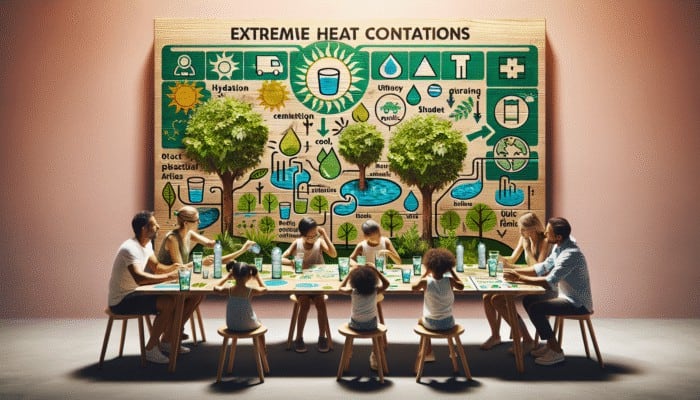Comprehensive Insights into Heatwaves and Their Impacts
Understanding the Complex Causes of Heatwaves

Urban Heatwave Survival: Heatwaves are not simply the outcome of unusually high temperatures; they arise from various atmospheric phenomena that interact in intricate ways. Typically, a heatwave occurs when persistent high-pressure systems establish themselves over a region, trapping warm air close to the surface. This phenomenon can result in extended extreme temperatures, lasting from days to several weeks. The severity of a heatwave can fluctuate based on various factors such as geographical location, seasonal conditions, and the particular time of year. Areas closer to the equator are especially susceptible due to their naturally warmer climates, experiencing more intense heatwaves than their counterparts in temperate zones.
Climate change is one of the most significant factors contributing to the increasing severity of heatwaves. As the average global temperature continues to rise, the conditions that facilitate the occurrence of heatwaves become more frequent and severe. The progressively expanding urban areas are crucial in exacerbating these conditions. The construction of buildings, roads, and other heat-absorbing materials leads to the phenomenon known as the urban heat island effect, where urban temperatures can soar significantly higher than those of surrounding rural areas. This effect underscores the need for urban planning strategies that consider heat management.
Gaining a deeper understanding of the causes behind heat waves is essential for devising effective strategies for urban heatwave survival. By implementing measures to reduce the impact of these extreme weather events, communities can better prepare for the challenges posed by rising temperatures. By recognising the root causes—atmospheric conditions and human activities—we can cultivate a more informed public equipped to face the difficulties brought on by heatwaves.
Exploring the Effects of Heatwaves on Urban Environments
Urban areas face distinct challenges during heatwaves due to the urban heat island effect. This effect arises when cities, characterised by dense clusters of buildings, asphalt, and other materials that absorb heat, become significantly warmer than their rural surroundings. For example, during a heatwave, urban centres such as New York, Tokyo, and Mumbai can experience temperature increases ranging from 5 to 10 degrees Celsius compared to nearby countryside areas, creating a stark contrast that can have serious implications for city dwellers.
The disparity in temperature between urban and rural areas can lead to many challenges. Elevated city temperatures translate to heightened energy demands, as more residents use air conditioning systems to cope with the heat. This surge in demand can strain existing power grids, resulting in outages, particularly in older cities with outdated infrastructure. Additionally, air quality tends to deteriorate during heatwaves due to increased ozone formation, leading to respiratory issues for many urban residents, particularly those with pre-existing health conditions.
The socioeconomic divide within urban settings further amplifies the impact of heatwaves. Marginalised populations, including low-income families and the elderly, may lack access to sufficient cooling resources, rendering them more vulnerable to heat-related health issues. Consequently, heatwaves can lead to increased mortality rates, especially among these at-risk groups. Cities must acknowledge these challenges and implement robust strategies to mitigate the effects of heatwaves, ensuring that all residents have equitable access to relief and support systems.
Assessing Health Risks Linked to Heatwaves
The health risks associated with heatwaves are both significant and multifaceted. One of the primary concerns is dehydration, which can escalate to more severe conditions like heat exhaustion or heatstroke. Symptoms of these serious health issues may include dizziness, rapid heartbeat, and confusion. Vulnerable populations, such as the elderly, young children, and individuals with pre-existing health conditions, are particularly at heightened risk during extreme heat events, necessitating informed community action.
Moreover, heatwaves can potentially exacerbate chronic health problems, including cardiovascular and respiratory diseases. The stress imposed by high temperatures on the human body can trigger serious health complications, including heart attacks. Research has demonstrated that hospital admissions for heat-related illnesses can skyrocket during severe heat waves, underscoring the urgent need for public awareness and preparedness initiatives.
To enhance urban heatwave survival, cities must roll out public health initiatives to educate residents about the dangers of extreme heat. This could involve establishing accessible communication channels to deliver timely updates regarding heat warnings and safety advice. Furthermore, local governments should collaborate with health organisations to develop outreach programmes to educate high-risk populations about the dangers of heatwaves and the significance of hydration and effective cooling measures.
Examining the Impact of Heatwaves on Agriculture

Heatwaves can severely damage agricultural systems, adversely impacting crop yields and livestock health. Extreme temperatures can result in soil moisture loss, making it challenging for plants to absorb the necessary nutrients vital for growth. For instance, regions such as Australia and parts of the American Midwest can experience drastic reductions in grain production during heatwaves, ultimately leading to economic losses and food shortages that ripple through the supply chain.
Livestock are also not exempt from the dangers posed by heatwaves. Animals can suffer from heat stress, leading to decreased milk production and, in severe cases, increased mortality rates. To mitigate these effects, farmers must adapt their practices by implementing strategies such as providing adequate shade, ensuring a reliable water supply, and adjusting feeding schedules to cooler parts of the day, thereby safeguarding their livestock’s health and productivity.
The economic implications of heatwaves on agriculture necessitate a thorough understanding of their impacts. Farmers and agricultural businesses must adopt innovative approaches to maintain productivity during these challenging climatic conditions. Implementing water-conserving irrigation systems and investing in heat-resistant crop varieties are crucial to ensuring food security, particularly as temperatures continue to rise. By taking these proactive measures, communities can bolster their resilience against climate-related challenges and enhance their overall urban heatwave survival strategies.
Implementing Strategies to Mitigate Heatwave Effects
Communities must adopt proactive strategies that prioritise prevention and mitigation to effectively tackle the challenges posed by heatwaves. A particularly effective approach is to expand green spaces within urban environments. Parks, gardens, and tree-lined streets not only provide shade but also contribute to cooling the surrounding air through evapotranspiration. This principle is exemplified in cities like Singapore, where integrating nature into urban design has proven successful in lowering ambient temperatures and improving overall quality of life.
Another vital strategy involves utilising reflective materials in construction. Buildings designed with cool roofs or reflective surfaces can dramatically reduce heat absorption, allowing interior spaces to remain cooler during extreme heat events. Incorporating these materials into urban planning is essential as cities continue to grow and evolve, ensuring they remain resilient against the impacts of rising temperatures.
Moreover, local governments should establish heat action plans tailored to their communities. These plans may involve creating public cooling centres, providing transportation to these facilities for those in need, and implementing heat health warning systems that alert residents to forthcoming heat events. Collaboration with community organisations can foster a culture of awareness and preparedness, enhancing the community’s overall resilience in the face of heat waves.
The strategies employed to mitigate the effects of heat waves require collaboration, innovation, and a commitment to sustainable urban practices. By focusing on expanding green spaces, utilising advanced materials, and developing community-based heat action plans, cities can significantly improve their urban heat wave survival capabilities, safeguarding residents against the dangers posed by extreme heat.
Effective Preparation for Upcoming Heatwaves
Strategically Creating a Heatwave Response Plan

Preparation is vital for successfully navigating the challenges posed by a heatwave. Developing a comprehensive heatwave response plan empowers individuals and families to act decisively when extreme temperatures strike. This plan should detail specific actions to undertake during a heatwave, such as maintaining proper hydration, understanding the importance of avoiding outdoor activities during peak sun hours, and identifying accessible locations where cooler environments can be found.
Implementing a hydration schedule is an effective method to ensure adequate fluid intake. Setting reminders to drink water regularly can help prevent dehydration, which is critical in extreme heat. Families should also discuss and agree upon enjoyable indoor activities that can be pursued during the sweltering heat, ensuring that everyone remains engaged and occupied while staying cool and safe.
Moreover, identifying local cooling centres is essential for effective preparation. Public libraries, community centres, and shopping malls often serve as air-conditioned spaces where residents can seek refuge during a heatwave. Knowing the locations of these centres and their hours of operation will allow families to adapt and find relief when temperatures soar quickly.
Sharing this heatwave response plan with friends and neighbours can foster community resilience. Communities that unite to prepare for heatwaves can significantly improve the overall effectiveness of their responses, ultimately contributing to better urban heatwave survival outcomes for all residents.
Essential Supplies to Stock for Heatwave Preparedness
Having essential supplies readily available during a heatwave can greatly enhance safety and comfort. Stocking up on water is the most critical aspect of preparation. Individuals should aim to have at least one gallon of water per person daily for the heatwave, ensuring that everyone remains adequately hydrated, even if they cannot leave their homes.
In addition to water, lightweight clothing can significantly enhance comfort during extreme heat. Breathable fabrics, such as cotton, allow for better ventilation and moisture-wicking properties. It’s advisable to avoid dark or heavy clothing that can trap heat and contribute to discomfort, opting instead for lighter-coloured, loose-fitting outfits that promote airflow.
Cooling devices are another essential component of any heatwave preparedness plan. Fans, portable air conditioners, and cooling towels can provide immediate relief from the heat. Families should aim to have a variety of cooling methods at their disposal, enabling them to manage indoor temperatures effectively. Furthermore, ice packs and frozen water bottles can serve as effective makeshift cooling solutions to keep cool when needed.
Being well-prepared with these essential supplies can dramatically improve the experience during a heatwave, enhancing urban heatwave survival efforts. Regularly checking supplies, making necessary purchases in advance, and clearly understanding how to use these items effectively will ensure that everyone is ready to face the challenges associated with periods of extreme heat.
Educating Family and Community Members about Heatwave Safety
Education plays a pivotal role in preparing for heatwaves and ensuring community resilience. Families should engage in discussions about the dangers associated with extreme heat, including the signs of heat-related illnesses. By raising awareness, individuals can recognise when someone is struggling with the heat and take appropriate action to assist them.
In addition to personal education, communities can benefit from outreach programmes designed to inform residents about the risks associated with heatwaves. Local governments and organisations can collaborate to disseminate valuable information through flyers, social media campaigns, and community meetings. Workshops can also be organised, providing practical tips on hydration methods, cooling techniques, and recognising the symptoms of heat stress.
Schools can serve as vital hubs for educating children about heat safety. Incorporating lessons that highlight the dangers of heat waves into the curriculum can empower young people to grasp the risks and share their knowledge with family members. Engaging students through interactive activities can enhance their retention of this critical information, equipping them with the tools they need to stay safe in extreme heat.
Fostering a culture of preparedness can significantly bolster urban heatwave survival efforts. An informed and educated community is better equipped to respond to heatwaves, ultimately reducing the overall impact on public health and safety. By prioritising education and awareness, communities can ensure that everyone can protect themselves and others when temperatures increase.
Monitoring Weather Forecasts for Heatwave Awareness
Staying informed about weather forecasts is vital for effective heatwave preparedness. Regularly monitoring forecasts allows individuals to anticipate the onset of extreme heat and plan accordingly. Reliable sources of information include local news channels, weather apps, and official meteorological services, which provide real-time updates on temperature predictions and heat advisories.
Setting up alerts for severe weather warnings can be particularly beneficial. Many weather apps and services allow users to customise notifications, ensuring they receive timely updates about imminent heatwaves. These alerts can serve as reminders to implement heatwave plans, such as stocking up on essentials or identifying nearby cooling centres.
Communities can also benefit from local government initiatives that provide comprehensive heatwave information. Establishing dedicated hotlines or websites with resources on heat safety can empower residents to stay informed and prepared. Knowing when to seek help or remain indoors during a heatwave can be crucial for maintaining safety and health.
The ability to monitor weather forecasts enhances individual preparedness and strengthens community resilience. When residents are equipped with timely information, they can collectively respond to heat waves, ensuring that everyone remains safe and supported during these challenging times. Communities can significantly bolster their urban heatwave survival strategies by prioritising weather awareness.
Identifying and Supporting Vulnerable Individuals During Heatwaves
Recognising individuals who may be particularly vulnerable during heatwaves is crucial for fostering community preparedness. The elderly, young children, and those with chronic illnesses are at heightened risk for heat-related health issues. Identifying these groups within your community allows for targeted support and intervention during extreme heat events, ensuring they receive the assistance they need.
Local organisations can play a vital role in outreach efforts aimed at vulnerable populations. Community centres, healthcare providers, and social service agencies can collaborate to identify individuals needing assistance during heat waves. This may include establishing check-in systems to ensure those at risk are safe and have access to necessary resources, such as hydration and cooling facilities.
Educating families about the signs of heat stress and the importance of monitoring vulnerable individuals can empower communities to take meaningful action. For example, family members should regularly check on elderly relatives to ensure they have adequate hydration and access to cooling environments, particularly during extreme heat events.
Creating a supportive network can enhance the overall survival of urban heatwave communities. By fostering connections among residents, individuals can ensure that those in need receive the help they require during challenging heatwave conditions. Collective vigilance and support can significantly reduce the impact of extreme heat on vulnerable populations, ultimately fostering a safer community for all.
Effective Ways to Stay Cool During a Heatwave
Utilising Effective Cooling Techniques for Comfort
Effective cooling techniques can dramatically enhance comfort and safety during a heatwave, and simple methods such as wet cloths can provide immediate relief. Individuals can quickly lower their body temperature by soaking a cloth in cool water and applying it to pulse points like wrists or neck. This technique is particularly beneficial for those who may not have access to air conditioning, making it a practical solution for many.
Cold showers or baths are another effective way to cool down during extreme heat. A quick dip can lower internal body temperature, providing respite from the oppressive heat. However, prolonged exposure to extremely cold water can lead to other complications, so moderation is key to ensuring safety while cooling down.
Creating shaded areas outdoors also contributes to relief from the sun’s harsh rays. Utilising umbrellas, canopies, or simply seeking natural shade from trees can protect individuals from direct sunlight. Additionally, encouraging outdoor activities during cooler parts of the day, such as early morning or late evening, can help avoid exposure to the most intense heat.
Implementing these cooling techniques enhances individual comfort and contributes to urban heatwave survival. Communities that promote these methods can establish a culture of awareness and preparedness, ensuring residents know how to stay safe during extreme heat events and effectively manage their well-being.
Modifying Your Home Environment for Comfort
Adjusting your home environment can be crucial in maintaining comfort during a heatwave. One effective tactic is to utilise curtains or blinds to block out sunlight during peak hours. This simple action can prevent excessive heat from entering your living space, helping to keep indoor temperatures cooler and more bearable.
Proper ventilation is another key consideration. Opening windows during the cooler parts of the day—typically early morning or late evening—can create cross-ventilation, allowing cooler air to flow through the home. Strategically using fans can also aid in circulating air, enhancing the overall cooling effect, and improving indoor comfort.
Investing in energy-efficient appliances can further contribute to a cooler home environment. Ceiling fans or portable air conditioners can provide much-needed relief during extreme heat events. Additionally, utilising exhaust fans in kitchens and bathrooms can help remove heat and humidity from cooking and bathing, creating a more comfortable living space.
Individuals can significantly enhance their urban heatwave survival strategies by modifying the home environment. Creating a cool, comfortable living space improves individual well-being and fosters a sense of community resilience during challenging heat conditions, ultimately enhancing safety for all residents.
Finding and Utilising Public Cooling Centres
Public cooling centres serve as invaluable resources during heat waves, providing safe and air-conditioned environments for individuals seeking refuge from extreme heat. Many cities establish these centres in community buildings, libraries, and recreational facilities, ensuring accessibility for residents needing a cooling space.
Identifying the nearest cooling centres is an essential step in heatwave preparedness. Local governments often provide information about available facilities through public announcements, websites, and social media platforms. Understanding the hours of operation and any requirements for use can help residents plan and ensure they can access relief when needed.
In addition to offering respite from the heat, these centres can act as social hubs, fostering community engagement and interaction. Many facilities host events or activities during heatwaves, allowing residents to connect with neighbours while remaining cool and comfortable.
Utilising public cooling centres is an effective strategy for enhancing urban heatwave survival. By fostering a sense of community and providing safe spaces, cities can ensure that all residents have access to the resources they need during extreme heat events, contributing to overall public health and safety.
Understanding Hydration and Nutrition During Heatwaves
Recognising the Importance of Staying Hydrated
Hydration is paramount during a heatwave, as even mild dehydration can lead to serious health consequences. The human body loses water through sweat, and the demand for hydration increases significantly during extreme heat. Maintaining proper fluid levels is essential for comfort and optimal functioning of vital bodily processes, including thermoregulation and metabolism.
The recommended daily water intake can vary based on age, weight, and activity level. However, during a heatwave, individuals should aim to consume at least 8 to 10 glasses of water daily, even if they do not feel thirsty. Staying ahead of your hydration needs can prevent fatigue, dizziness, and other heat-related illnesses when the body is deprived of essential fluids.
Incorporating hydrating foods into your diet can also enhance overall fluid intake. Foods like watermelon, cucumbers, and oranges are excellent water sources that can help keep the body hydrated while providing essential nutrients. Snacking on these fruits can be a refreshing way to combat the heat while maintaining proper hydration levels.
Prioritising hydration is a critical component of urban heatwave survival. By understanding the importance of fluid intake and actively incorporating strategies to maintain hydration, individuals can protect themselves from the dangers posed by extreme heat and enhance their overall well-being during these challenging conditions.
Choosing Nutritious Foods During Heatwaves
During a heatwave, selecting water-rich foods can be a game-changer for hydration and overall well-being. Fruits and vegetables contribute to hydration and provide essential vitamins and minerals that can support bodily functions during extreme heat. For instance, cucumbers and strawberries comprise over 90% water, making them ideal for keeping cool and hydrated during hot weather.
Incorporating salads and smoothies into your meals can also be beneficial. These dishes allow for creative combinations of hydrating ingredients, such as leafy greens, fruits, and yogurt, which can provide both nutrients and hydration. Additionally, cold dishes require minimal cooking, helping to keep your kitchen cooler during hot days, thus promoting a more comfortable cooking environment.
Limiting heavy, rich meals during a heatwave is wise, as these can lead to increased feelings of lethargy and discomfort. Instead, opt for lighter fare that is easier to digest. Foods rich in electrolytes, such as coconut water and bananas, can help replenish essential nutrients lost through perspiration, ensuring the body remains balanced and functioning optimally.
Individuals can enhance their urban heatwave survival strategies by prioritising nutritious, hydrating foods. Maintaining a balanced diet during extreme heat will support hydration and promote overall health and comfort during challenging weather conditions, ultimately contributing to improved well-being and resilience.
Avoiding Dehydrating Substances During Heatwaves
During a heatwave, being mindful of substances contributing to dehydration is crucial. Alcohol and caffeine are two common culprits that can exacerbate fluid loss, leading to increased risks of dehydration. Consuming beverages high in caffeine—such as coffee, energy drinks, or sodas—can lead to increased urination, ultimately resulting in fluid loss and heightened vulnerability to heat-related issues.
While it may be tempting to indulge in refreshing cold drinks, moderation is key. Ensuring that equal water is also consumed for every caffeinated or alcoholic beverage can help maintain hydration levels. Choosing non-caffeinated, hydrating alternatives, such as herbal teas or infused water, can provide enjoyable options without the dehydrating effects.
Staying away from overly sugary drinks is essential during heat waves. High sugar content can lead to rapid spikes and drops in energy levels, leaving individuals feeling sluggish and fatigued. Opting for naturally flavoured water or electrolyte-replenishing drinks can provide hydration without added sugars, allowing for a more balanced approach to fluid intake.
Individuals can significantly enhance their urban heatwave survival efforts by avoiding dehydrating substances. A mindful approach to beverage choices during extreme heat will help maintain hydration levels and overall well-being, ensuring a safer and more comfortable experience during challenging weather conditions.
Maintaining Electrolyte Balance During Heatwaves
Maintaining electrolyte balance during a heatwave is essential for overall health and hydration. As the body sweats to regulate temperature, it loses water and critical electrolytes such as sodium, potassium, and magnesium. These minerals are vital for muscle function and hydration; losing them can lead to cramps, fatigue, and dizziness, further complicating the body’s response to extreme heat.
Replenishing electrolytes can be achieved through a combination of foods and drinks. Sports drinks, coconut water, and electrolyte tablets are designed to restore lost minerals quickly. However, choosing options with lower sugar content is essential to avoid unnecessary energy spikes and ensure a balanced approach to hydration.
Including electrolyte-rich foods in your diet can help maintain balance effectively. Bananas, spinach, and avocados are rich in potassium, while nuts and seeds provide magnesium and sodium. Incorporating these foods into your meals can support hydration and overall health during extreme heat events, ensuring the body remains balanced and optimal.
Emphasising electrolyte balance is crucial for urban heatwave survival. By understanding the importance of replenishing lost minerals and incorporating dietary strategies, individuals can enhance their resilience against the challenges posed by heat waves. Staying conscious of electrolyte needs will ensure optimal hydration and well-being during extreme temperatures.
Protecting Vulnerable Populations During Heatwaves
Providing Care for the Elderly During Heatwaves
Elderly individuals are particularly vulnerable during heat waves, making it essential to ensure they have access to cool environments and adequate hydration. Extreme heat can exacerbate pre-existing health conditions, increasing the risk of heat-related illnesses. As caregivers or family members, it is crucial to regularly check in on elderly relatives, especially during extreme heat events, to ensure their well-being and safety.
Proper hydration is one of the most vital aspects of caring for older people during heat waves. Encouraging regular fluid intake, even when they do not feel thirsty, can prevent dehydration and related health complications. Various hydrating options, such as fruit-infused water or electrolyte drinks, can make staying hydrated more appealing and enjoyable for elderly individuals.
It is also essential to assist elderly individuals in finding relief from the heat. Ensuring they have access to air-conditioned spaces or cooling centres can significantly reduce the risk of heat stress. If these options are not available, creating a cool environment at home through fans, wet cloths, and shade can help maintain their comfort and safety during extreme heat.
By prioritising the needs of the elderly during heat waves, communities can significantly enhance their urban heat wave survival efforts. A proactive approach to caring for this vulnerable population can help prevent health complications and ensure everyone remains safe during extreme heat events, ultimately fostering community and support.
Safeguarding Children from Heat-Related Risks
Children are among the most vulnerable during heat waves and require special attention to ensure their safety and well-being. Young children may not recognise the signs of heat stress, so caregivers must be proactive in monitoring their exposure to extreme temperatures. Keeping children out of direct sunlight during peak hours is crucial to preventing heat-related illnesses and ensuring their health.
Encouraging hydration is another vital aspect of safeguarding children during extreme heat. Providing fun, hydrating snacks—such as popsicles made from fruit juice or smoothies—can make drinking water more enjoyable for young ones. Establishing a routine where children are reminded to drink water regularly can promote healthy hydration habits, helping to prevent dehydration during heat waves.
Outdoor play should be carefully monitored during heat waves. Choosing cooler times of the day for outdoor activities can help minimise exposure to extreme temperatures. Activities encouraging shade, such as visiting parks with trees or playing in water, can relieve the heat while keeping children engaged and active safely.
Communities can significantly enhance their urban heatwave survival strategies by prioritising children’s needs and fostering a safe environment. Engaging families in heat safety education can empower caregivers to protect their children during challenging heat events, ensuring that all young residents remain safe and healthy while navigating the challenges posed by extreme heat.
Supporting Individuals with Chronic Illnesses During Heatwaves
Individuals with chronic illnesses may face heightened risks during heat waves, necessitating close monitoring and support. Conditions such as heart disease, diabetes, and respiratory illnesses can be exacerbated by extreme heat, making it essential to provide assistance and resources during these challenging periods. Caregivers should remain vigilant and prepared to help those who need it most.
Encouraging regular check-ins with individuals who have chronic illnesses can help ensure their well-being during heat waves. Family members and friends should watch for any signs of heat stress and be ready to assist them in accessing cooling resources. Having a plan for emergencies can also provide peace of mind for those particularly vulnerable during extreme heat events.
Hydration is critical for those with chronic illnesses, as it can help alleviate some symptoms and support overall health. Reminding individuals to drink fluids and offering a variety of hydrating options can encourage them to stay hydrated. It’s important to consider dietary restrictions while suggesting electrolyte-rich foods and beverages to ensure they remain safe and comfortable.
Communities play a vital role in supporting individuals with chronic illnesses during heatwaves. Establishing outreach programmes that connect these individuals with resources and assistance can enhance urban heatwave survival efforts. By fostering a network of support, communities can significantly reduce the risks associated with extreme heat for the most vulnerable, ensuring their health and safety during challenging conditions.
Assisting the Homeless Population During Extreme Heat
The homeless population is particularly at risk during heat waves, facing unique challenges in accessing cooling resources and hydration. Assisting homeless individuals during extreme heat events is crucial for preventing heat-related illnesses and ensuring their safety. Community members and local organisations can provide support and assistance during these challenging times.
Providing access to cooling centres is essential. Local governments can collaborate with community organisations to create programmes that transport homeless individuals to air-conditioned facilities, ensuring they have a refuge from the heat. Furthermore, distributing bottled water and cooling supplies, such as hats or fans, can help alleviate the immediate effects of heat exposure, providing much-needed relief.
Outreach teams can be critical in connecting homeless individuals with resources during heat waves. These teams can provide information about available cooling centres, distribute supplies, and offer health services to those in need. Creating a culture of compassion and support can significantly impact the safety of vulnerable populations during challenging heat events, ultimately fostering a more inclusive society.
By prioritising the needs of people experiencing homelessness during heat waves, communities can enhance their overall urban heat wave survival strategies. Establishing a network of support and resources ensures that everyone has access to the relief they need during extreme heat events, fostering a sense of community and care for all residents.
Protecting Pregnant Women During Heatwaves
Pregnant women face unique challenges during heatwaves, necessitating special attention to their well-being. High temperatures can increase the risk of heat stress and dehydration, negatively impacting the mother and the developing baby. Ensuring pregnant women have access to hydration and cooling resources is crucial for their health and safety during extreme heat events.
Encouraging regular fluid intake is vital during extreme heat. Pregnant women should be reminded to drink water consistently throughout the day, even if they do not feel thirsty. Incorporating hydrating foods, such as fruits and vegetables, into their diet can also support overall hydration and well-being.
Creating a comfortable environment is essential for pregnant women during heat waves. Providing shade, air conditioning, or access to cool baths can help alleviate heat stress. Encouraging rest during the hottest parts of the day can also promote well-being, ensuring that pregnant women feel supported and safe while navigating the challenges posed by extreme heat.
By prioritising the needs of pregnant women during heat waves, communities can significantly enhance their urban heat wave survival strategies. Fostering an environment that supports health and hydration is crucial for ensuring the safety of both mothers and their unborn children during challenging heat events.
Managing the Impact on Pets and Wildlife During Heatwaves
Ensuring Pets Remain Cool and Comfortable
Like humans, pets are susceptible to heat-related illnesses during a heatwave, making it essential to take proactive measures to keep them cool and safe. Providing shade and access to fresh water prevents heat stress in pets. Creating shaded areas in yards or using pet-friendly umbrellas can help protect them from direct sunlight, ensuring their safety and comfort.
Avoiding walks during the hottest parts of the day is critical for pets. Opting for early morning or late evening strolls can help minimise exposure to extreme heat and prevent heat-related issues. Additionally, paying attention to the signs of heat stress in pets—such as excessive panting, drooling, or lethargy—is essential for prompt intervention and care when needed.
Providing indoor pets with cooling mats, fans, or air conditioning can enhance their comfort during extreme heat. These solutions can help regulate their body temperature and ensure they remain safe and comfortable. If possible, keeping pets indoors during heat waves is often the best approach to safeguarding their well-being and protecting them from the dangers of extreme temperatures.
By prioritising pet care during heat waves, communities can significantly enhance their overall urban heat wave survival strategies. Engaging pet owners in education about heat safety can help ensure that all animals remain safe and healthy during extreme temperatures, ultimately fostering a compassionate environment for all community members.
Considerations for Wildlife During Heatwaves
During heat waves, wildlife faces challenges due to rising temperatures and diminishing water sources. Ensuring that natural habitats provide adequate resources for wildlife is crucial for their survival and well-being. Providing water stations in parks or natural reserves can help support local wildlife and prevent dehydration, ultimately contributing to the health of local ecosystems.
Maintaining natural vegetation is essential for wildlife protection during extreme heat. Trees and shrubs provide crucial shade and habitat for various animal species, helping them escape the sweltering sun. Communities can engage in conservation efforts that prioritise the preservation of natural habitats, promoting biodiversity and resilience within local ecosystems.
Educating residents about the importance of supporting local wildlife during heat waves can also foster a culture of awareness and compassion. Encouraging responsible practices, such as avoiding the use of pesticides or providing supplemental food and water, can help ensure that wildlife remains healthy and has access to the resources it needs during challenging conditions.
By considering the needs of wildlife during heat waves, communities can enhance their urban heat wave survival strategies. Taking proactive measures to support local ecosystems fosters a sense of responsibility for nature and promotes overall community resilience during extreme temperatures, ultimately benefiting wildlife and human populations.
Emergency Care for Pets During Heatwaves
Understanding how to respond to heatstroke in pets is essential for safeguarding their health during heat waves. Recognising the signs of heat stress—such as rapid panting, vomiting, or collapse—can make a critical difference in ensuring timely intervention. If a pet exhibits these symptoms, acting quickly and providing the necessary care is vital.
Immediate steps include moving the pet to a cooler environment, providing fresh water, and applying cool (not cold) water to the pet’s body to help lower its temperature. Veterinary care may be necessary if the pet shows severe symptoms, highlighting the importance of having a pet care plan for emergencies during heat waves.
Pet owners should also be aware of their animal’s breed-specific needs. Certain breeds, such as brachycephalic dogs (e.g., Bulldogs and Pugs), are more susceptible to heat stress due to their unique respiratory systems. Understanding these risks allows owners to take specific precautions to protect their pets effectively during extreme heat events.
Communities can enhance urban heatwave survival strategies by prioritising emergency pet care and understanding the signs of heat stress. Creating awareness and educating about pet care during heatwaves ensures that all animals are protected and cared for during extreme temperatures, ultimately contributing to a safer and healthier environment.
Community and Government Responses to Heatwaves
Understanding the Critical Role of Local Authorities
Local authorities are crucial in managing heatwaves and protecting residents from harmful effects. Governments can proactively establish cooling centres in accessible locations throughout the community. These facilities serve as vital resources during extreme heat, offering air-conditioned environments for those needing relief from the sweltering temperatures.
Additionally, local authorities can implement effective communication strategies to inform residents about heatwave risks and available resources. Utilising social media, local news outlets, and community bulletins can ensure that vital information reaches a broad audience. Providing clear guidelines on staying safe during heatwaves can empower individuals to take appropriate actions to protect themselves and their families.
Collaboration with community organisations is essential for an effective response to heatwaves. Local NGOs and health agencies can work alongside governments to develop outreach programmes that target vulnerable populations, ensuring they receive the support and resources they need during extreme heat events. These partnerships can enhance the overall effectiveness of community responses to heatwaves, ensuring that no one is left behind.
By recognising the vital role of local authorities in managing heat waves, communities can strengthen their overall urban heat wave survival strategies. Through collaboration, effective communication, and accessible resources, local governments can significantly reduce the risks associated with extreme heat and promote the health and safety of all residents.
Frequently Asked Questions about Heatwaves
What are heatwaves, and how do they occur?
Heatwaves are prolonged periods of excessively high temperatures, often accompanied by high humidity. They typically occur due to high-pressure systems trapping heat in an area, resulting in extreme temperatures that can last days or weeks.
How can I effectively prepare for a heatwave?
Preparation for a heat wave involves creating a comprehensive heat wave plan, stocking essential supplies such as water and cooling devices, and educating family and community members about the dangers of extreme heat and how to stay safe.
What are the health risks associated with heat waves?
Health risks during heatwaves include dehydration, heat exhaustion, and heatstroke, particularly for vulnerable populations like the elderly, young children, and those with chronic illnesses. Recognising these risks is crucial for prevention and care.
What foods are best to consume during a heatwave?
During a heatwave, it’s advisable to consume water-rich foods such as fruits and vegetables. Options like watermelon, cucumbers, and smoothies can help maintain hydration while providing essential nutrients to support health during extreme heat.
How can communities support vulnerable populations during heat waves?
Communities can support vulnerable populations by implementing outreach programmes, establishing cooling centres, and ensuring access to hydration and cooling resources for those in need during extreme heat events.
What are cooling centres, and where can I find them?
Cooling centres are designated public spaces that offer air-conditioned environments for residents seeking relief from extreme heat. They can include community centres, libraries, and other facilities; information about them is usually available through local government announcements and websites.
How can I keep my pets safe during a heatwave?
To keep pets safe during a heatwave, provide shade, ensure access to fresh water, avoid walking during peak heat hours, and monitor them for signs of heat stress. Taking these precautions can help protect their health and well-being.
What should I do if my pet shows signs of heatstroke?
If your pet exhibits signs of heatstroke, immediately move them to a cooler environment, provide fresh water, and apply cool water to their body to help lower their temperature. Seek veterinary care if symptoms are severe, ensuring their health and safety during extreme heat.
Why is staying hydrated so important during a heatwave?
Hydration is crucial during a heatwave to prevent dehydration and maintain bodily functions. High temperatures increase the risk of fluid loss, making regular water intake essential for health and well-being.
How can I help wildlife during heatwaves?
You can help wildlife during heatwaves by providing water sources in your yard, maintaining natural vegetation for shade, and avoiding harmful pesticide use that can affect local ecosystems and wildlife health during extreme temperatures.
Explore our world on X!
Urban Self-Defense Basics: Essential Techniques
Essential Self-Defense Principles for Personal Safety What Are the Fundamental Principles of Self-Defense? Urban Self-Defense Basics: Grasping the fundamental principles of self-defense is vital for effective personal protection and safety. These principles not only inform the techniques employed but also cultivate the mindset necessary for successful self-defense engagements. The core principles encompass: Awareness: Cultivating an […]
Urban Bug-Out Routes: Essential Planning Guide
Mastering Urban Bug-Out Routes for Safe Escapes What Are Urban Bug-Out Routes and Why Are They Essential? Urban Bug-Out Routes: Urban bug-out routes are meticulously pre-planned escape pathways specifically crafted for navigating through urban environments. In densely populated cities, where streets can quickly descend into chaos during emergencies, having a clearly defined route is not […]
Surviving a Curfew: Essential Tips and Strategies
Essential Steps for Effectively Preparing for a Curfew How to Stock Up on Vital Supplies Before a Curfew Surviving a Curfew: During a curfew, having the right supplies readily available is essential for maintaining both your physical health and mental well-being. When preparing for a curfew, it is crucial to plan and stock up on […]
Surviving Apartment Lockdowns: Essential Tips
Essential Steps to Prepare Your Apartment for Lockdowns Stocking Up on Vital Supplies for Lockdowns Surviving Apartment Lockdowns: Ensuring your apartment is adequately stocked with essential supplies is an indispensable first step in surviving apartment lockdowns. Having a sufficient quantity of food, water, and medication not only equips you for unexpected situations but also alleviates […]








It’s really interesting how you’ve laid out the multifaceted nature of heatwaves. It makes me reflect on my own experiences during extreme heat events, especially living in an urban area where the heat island effect seems to amplify the discomfort. I remember last summer, when the local parks became a refuge for many of us seeking a little relief under the shade of trees that had become scarce in our built-up environment. It’s incredible to think about how something as complex as atmospheric pressure systems can lead to such profound impacts on our daily lives and health.
This post really highlights how interconnected our climate systems are and how urban areas can intensify heatwaves. Living in a city myself, I’ve often noticed how much hotter it feels in the concrete jungle compared to the surrounding countryside. It makes me think about how we can adapt our urban planning to mitigate these effects—like incorporating more green spaces or reflective materials in construction.
It’s interesting to hear how your experience in the city mirrors the challenges many urban areas face. The phenomenon you mentioned is often referred to as the urban heat island effect, where developed areas trap heat more than surrounding rural regions. Adding green spaces is definitely one of the most effective ways to combat that. Parks, green roofs, and urban gardens not only cool things down but also improve air quality and provide a habitat for wildlife.
You’re touching on an important aspect of urban living. The difference in temperature between city centers and surrounding areas often feels surprising, doesn’t it? This phenomenon, often referred to as the urban heat island effect, highlights how our built environments can trap and amplify heat.
“I’m glad you found the post insightful! To explore more ways we can make our cities cooler and more sustainable, check out this resource on innovative urban planning strategies.”
https://survivalbite.com/wild
Your exploration of heatwaves and their complex causes resonates deeply, particularly as we witness the increasing frequency and intensity of these events. The interplay of high-pressure systems and persistent heat is indeed a critical element, which I believe often gets overshadowed by more immediate concerns like extreme weather.
The way you articulate the connection between heatwaves and their underlying causes captures a vital aspect of our climate discourse. It really drives home how interconnected everything is, and how those high-pressure systems play a powerful role in shaping weather patterns that we often take for granted. As you’ve pointed out, the focus tends to shift toward acute weather events like storms or floods, while the more subtle, chronic effects of heat are sometimes overlooked.
Thank you for your thoughtful comment! If you’re interested in diving deeper into the causes and implications of heatwaves, check out this insightful resource that expands on these critical issues.
https://survivalbite.com/LostFoods
It’s striking how our understanding of heatwaves, their causes, and impacts continues to evolve, especially as we face an undeniable rise in their frequency and intensity. You’ve brought up an important point about the role of high-pressure systems. These phenomena can create a sort of atmospheric ‘cap’ that allows heat to build up, often leading to prolonged periods of scorching temperatures. While this is an essential part of the narrative, I think it’s also vital to reflect on how these systems interact with broader climate trends, like changes in ocean temperatures and shifts in wind patterns.
Thank you for your thoughtful comment! If you’re interested in diving deeper into the broader impacts of climate patterns, I invite you to check out this resource that elaborates on these crucial connections.
https://survivalbite.com/wild
Your exploration of heatwaves not only highlights their complex atmospheric roots but also sparks a deeper reflection on how climate change is reshaping our environment and daily lives. Living in a region that has recently experienced record-high temperatures, I’ve seen firsthand the challenges heatwaves pose, particularly in urban areas where the heat can feel magnified. It’s striking how these high-pressure systems can trap not just warm air, but also the vitality of communities, forcing us to rethink our urban planning and public health strategies.
It’s fascinating to delve into the complex interplay of atmospheric phenomena that lead to heatwaves. When you mentioned the role of persistent high-pressure systems, it reminded me of how often these weather patterns disrupt our daily lives, particularly in urban settings. My city has been experiencing more frequent and intense heatwaves over the past few years, and the impact on public health has been striking.
I found your insights on the interplay between atmospheric phenomena and heatwaves fascinating. It really emphasizes how these events are shaped by various factors beyond just temperature. Living in a city that often falls prey to urban heat islands, I’ve seen firsthand how urban planning—or the lack thereof—can intensify these conditions.